13 Provencal desserts
CAMBRIDGE — Holidays are a time to celebrate tradition, but if your family is on another continent, you have to bring the traditions with you.
This is what Fabien Fieschi, 39, consul general of France in Boston, has done. Originally from the coastal city of Marseille, Fieschi (pronounced Fee-es-key) arrived in this post in August and won’t be home for Christmas. Instead, he will have a Provencal-style celebration here, with his Japanese wife, Yuki, 40, and their sons, Emilien, 9, and Julien, 7, at a table spread with Les Treize Desserts de Noël, the 13 desserts of Christmas. They will also gather around a small creche that his mother, Jacqueline, made for this peripatetic family.
The Provencal holiday table is laden with food and symbolism. Three candlesticks and three tablecloths, layered one on top of the other, signify the Holy Trinity. The 13 desserts represent the 12 Apostles and Christ at the Last Supper. This feast of sweets follows Gros Souper (grand meal), the Christmas Eve menu, which is a multicourse fish dinner.
When it comes time for dessert, each guest must taste all 13. “We enjoy Sauternes or muscat [wines] with them,” says Fieschi. Items on the table vary by family and region, but all include a decorative bread, dried fruits and nuts, fresh winter fruits, and some confections.
“My earliest memory of the 13 desserts,” says Fieschi, “is my mother, who is not originally from [Provence], making the pompe a l’huile.” Literally “oil pump,” that yeasty flatbread is scented with orange-flower water. In the Fieschi residence on Christmas Eve, another yeast flatbread, called fougasse, is on the menu. In the kitchen, chef Etienne Jaulin, 54, rolls and stretches fougasse dough into triangles, and makes slits in them, separating the dough to resemble leaves.
Jaulin trained as a pastry chef in Paris and has been cooking at the residence since last spring, before the Fieschi family arrived. He has lived in the United States for 29 years, working in restaurants and the food industry in Washington, D.C., Virginia, North Carolina, and Iowa. He shops, plans menus, and cooks for official events. “I always ask the citizenship of the guests,” says Jaulin. “If the French are coming I prepare sweetbreads and a cheese course. Most Americans don’t like that, so I make a beef daube [stew] when they come.”
On the celebration table, fougasse is always torn and shared among the guests, as Christ would have done it, never cut. If it is cut, bad luck will follow. The savory fougasse resembles Italian focaccia in taste, but the texture is a bit crunchier, the dough mixed with olive oil, the top sprinkled with thyme, rosemary, sea salt, pepper, and olives.
With his curly blond hair, jeans, and neon green sneakers — “They are comfortable,” says the chef, mischievously — Jaulin could fit right into a hip American restaurant kitchen. He slides each bread onto cornmeal-dusted baking sheets, and sends them into a 500-degree oven in the Wolf range. It is the only professional equipment in the kitchen. He is also baking traditional fennel and cumin cookies.
Also on the table go dried fruits such as figs and raisins, along with hazelnuts, walnuts, and almonds. The colors are thought to recall the religious order garb of Dominicans, Franciscans, Carmelites, and Augustinians.
In the French countryside, whether or not the dessert table is elaborate depends on a family’s income. “You know, it is like if you make minimum wage, you have an apple. If you make more money, you have tarte Tatin,” Jaulin says.
He grew up eating buche de Noel, the rolled cake made with a soft sponge, filled with butter cream icing, and covered with chocolate icing combed with a special fork to re-create the lines of a log. His own modern take on this French classic is a frozen version that he makes with rods of different flavored ice cream set between thin layers of genoise.
Among the other specialties on many traditional tables are a variety of candied fruits (chestnut, pear, apricot, tangerine), quince paste, apricots or prunes stuffed with nuts or almond paste, and candied citron. There are also white and black rectangles of nougat, a confection made with sugar, egg whites, honey, and nuts, another specialty of Provence. The white is soft and chewy, the black hard and crunchy. They represent good and evil and/or the changing of the season into winter. Citruses, apples, pears, and white grapes and winter melons are prominently displayed.
The large dining room has a fireplace and windows overlooking a garden. Two walls are covered with French-made reproduction wallpaper, put in five years ago, depicting a panoramic scene titled “Boston Harbor,” by a French artist in 1834.
Fieschi, who has Corsican ancestry, has just returned from France with confections for the celebration: the candied fruits, chestnuts, nougat, and the famous Calissons d’Aix, small oval confections made from almond paste covered with royal icing. Yuki Fieschi was particularly happy to see the marrons glaces (candied chestnuts). She peels away the gold foil from each one and announces, “These are delicious.”
The Brattle Street residence where the Fieschis live is now owned by the French government. It was built in 1917 for artist Albert Felix Schmitt, a member of the Boston School of painters and of the Guild of Boston Artists. The entire top floor was once the artist’s studio and has a magnificent skylight.
Although most formal dinner parties are held on the first floor, the massive light-filled atelier, with a grand piano, is a fine setting for larger events. A kitchen on that floor saves Jaulin many trips up and down three flights.
Fabien Fieschi, who is fluent in Japanese, attended a Japanese university for a year. His fields of expertise are Asia and strategic affairs, and his postings have including the United Nations in New York, Tokyo, and Paris. France has had a mission in Boston since 1768, he says. He met his wife in Tokyo, where she studied clothing design. At the time she spoke almost no French, but is fluent now and chats away comfortably with Jaulin to plan menus. Their sons move easily between Japanese and French and are learning English at the International School of Boston.
After Christmas, says Fabien Fieschi, “We also celebrate Japanese New Year’s traditions by eating toshikoshi soba [noodles] on New Year’s Eve and mochi [sticky rice cakes] on January 1st.”
The consul general’s responsibilities extend to all the New England states (there are nine other French consulates in the country in addition to the embassy in Washington). There are about 7,500 French citizens living in this region, to whom the consul provides support. “We also work with French business, small labs, and faculty doing research,” explains Fieschi. The office also offers services to non-French citizens who seek to study, visit, or do business in France.
Jaulin takes the fennel and cumin cookies from the oven and sets them on a plate.
He tucks whole almonds into molded logs of almond paste and places them between rows of cookies, then rolls apricots and prunes, also stuffed with almond paste, into sugar to sparkle the edges.
The fougasse and a footed dish of fruits are in the center of the table. Yuki Fieschi places the nougat on a small plate.
All the confections Fabien Fieschi brought with him from France are artfully arranged. “Calissons d’Aix were my favorites growing up,” he says.
Jaulin dashes into the garden and cuts pine boughs for a splash of green.
The Fieschis unwrap the hand-painted creche and set it on a table in the hall.
“The important thing to remember,” says Fabien Fieschi, “is that the baby Jesus is absent from the scene until Christmas, the day of his birth.”
They are not really without family. They have their traditions.

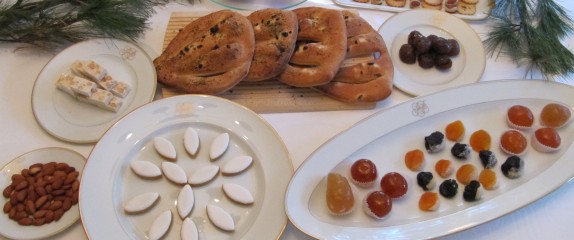
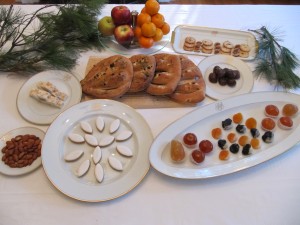
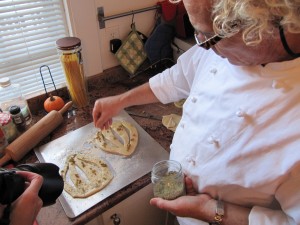
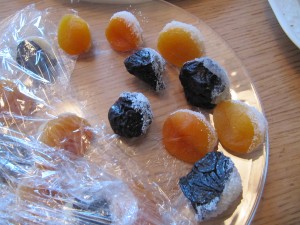
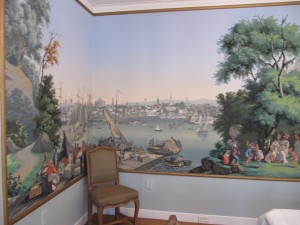
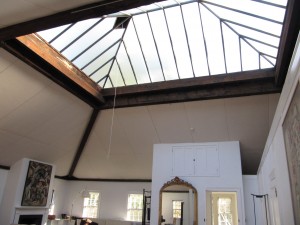
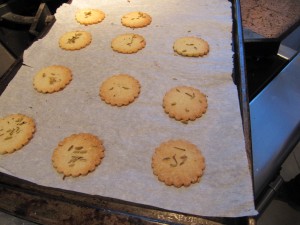
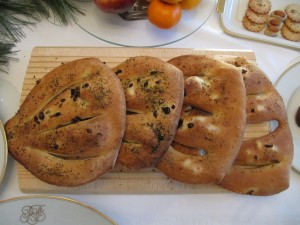
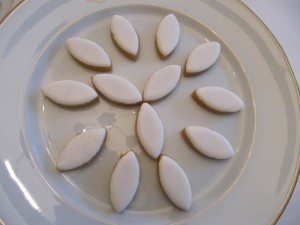
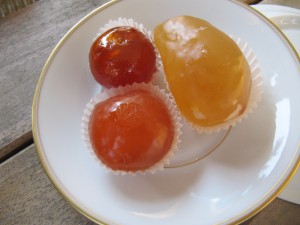
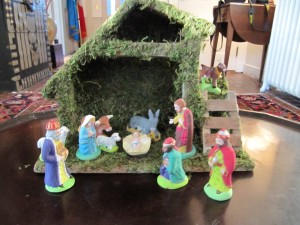









 Debra Samuels, bestselling author, food writer and cooking instructor,
Debra Samuels, bestselling author, food writer and cooking instructor, 


